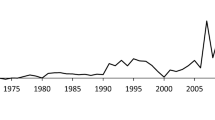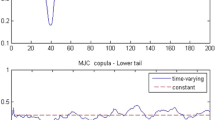Abstract
In response to the currency crises in the emerging market economies (EMEs) during the 1990s, earlier studies tended to put emphasis on identifying and explaining currency crash, which is an extreme event mostly associated with massive capital reversals. After the 2008 global financial crisis, the focus shifted towards enormous capital inflows which have put a sharp appreciation pressure on domestic currency and inflated a large housing and construction bubble. In this paper, we examine the foreign exchange instabilities of a group of EMEs between 1995Q1 and 2019Q4 using the exchange market pressure (EMP) index by taking into considerations both extreme positive and negative episodes. The identification of tail observations is carried out under the framework of Extreme Value Theory (EVT) to handle asymmetric and heavy-tailed data. A panel multinomial logit model is used to explore whether the predictors differ between extreme positive and negative EMP events. Our findings show that (1) there is asymmetry in the EMP distributions, where the occurrence of currency crises is more frequent than excessive appreciations in most EMEs, (2) portfolio and credit flows are significant predictors to both extreme events, and (3) by distinguishing the residency of capital flows, foreign credit flow is the key factor that contributes to the devaluation pressure in the EMEs.






Similar content being viewed by others
Notes
One such example is Endaka Fukyo, which is a recession period faced by Japan as net exports deteriorated due to strong yen revaluation in the aftermath of 1985 Plaza Accord agreement (Obstfeld 2009)
For instances, Weymark (1995, 1998), Burdekin and Burkett (1990) conduct EMP research for Canada; Connolly and Da Silveira (1979) for Brazil; Brissimis and Leventakis (1984) for Greece; Kim (1985) for Korea; Thornton (1995) for Costa Rica; Baig et al. (2003) for India; Parlaktuna (2005) for Turkey; Jeisman (2005) for Australia; De Macedo et al. (2009) for five African countries.
Pentecost et al. (2001) propose Principal Component Analysis (PCA) to determine weights of EMP components. Hegerty (2013) compare PCA measure with variance-weighted measures. He finds that many countries’ EMP components do not produce appropriate principal components and concludes that PCA measure might not serve as a definitive improvement over the variance-weighted measure.
According to Mundell-Fleming model, at a given policy rate, capital inflows are contractionary to the real economy through exchange rate appreciation (Blanchard et al. 2016). Kappler et al. (2013) identify large nominal and real appreciations and find that these episodes are associated with deterioration in current account balances. Mehrotra (2007) finds that in both Japan and Hong Kong, an appreciation in nominal effective exchange rate leads to a statistically significant decline in real output and price level. Ghosh and Rajan (2007) study the degree of nominal effective exchange rate pass-through into the export prices of Korea, Thailand and Singapore and find asymmetric pass-through between appreciation and depreciation.
Other investments consist mostly of foreign bank lending, which are also known as credit inflows in other studies (Rey 2015)
Using 4-quarter moving sum of capital inflows data, we compute the rolling means and standard deviations of the year-over-year(yoy) changes of capital inflows over 12 quarters. Extreme capital inflows episodes are determined when three criteria are met: (1) current yoy changes exceed two-standard-deviations band, (2) the episode lasts for all consecutive quarters for which the yoy changes exceed one-standard-deviation band, (3) the length of the episode is greater than one quarter.
df is allowed to take an increment of 0.1 from 1 to 5 and 0.2 from 5 to 10.
k is allowed to vary from 1% to 20% of n.
As US interest rate is used to compute EMPit, it enters as lag into RHS of Eq. 1 to avoid endogeneity problem.
In light of possible fixed effect, the hybrid multinomial logit approach as proposed by Allison (2009) is adopted for further sensitivity check. The qualitative findings are largely similar to our baseline results which are available upon request.
We also control for a third group in which both extreme positive and negative episodes occur within the same quarter. The result is not reported as there are only 36 observations fall within this group.
Correlation between reserve to GDP ratio and Chinn-Ito financial openness index is 0.14 at 1% significance level.
References
Ahmed S, Zlate A (2014) Capital flows to emerging market economies: a brave new world? J Int Money Finance 48:221–248
Aizenman J, Binici M (2016) Exchange market pressure in OECD and emerging economies: Domestic vs. external factors and capital flows in the old and new normal. J Int Money Finance 66:65–87. Elsevier
Aizenman J, Lee J, Sushko V (2012) From the great moderation to the global crisis: exchange market pressure in the 2000s. Open Econ Rev 23 (4):597–621
Allison Paul D (2009) Fixed Effects Regression Models, vol 160. SAGE publication
Baig MA, Narasimhan V, Ramachandran M (2003) Exchange market pressure and the Reserve Bank of India’s intervention activity. J Policy Model 25(8):727–748
Blanchard O, Ostry JD, Ghosh AR, Chamon M (2016) Capital flows: expansionary or contractionary? Am Econ Rev 106(5):565–569
Boonman TM, Jacobs JP, Kuper GH, Romero A (2019) Early warning systems for currency crises with real-time data. Open Econ Rev 30 (4):813–835
Brissimis SN, Leventakis JA (1984) An empirical inquiry into the short-run dynamics of output, prices and exchange market pressure. J Int Money Finance 3(1):75–89
Broner F, Didier T, Erce A, Schmukler SL (2013) Gross capital flows: dynamics and crises. J Monet Econ 60(1):113–133
Bruno V, Shin HS (2015) Capital flows and the risk-taking channel of monetary policy. J Monet Econ 71:119–132
Burdekin RC, Burkett P (1990) A re-examination of the monetary model of exchange market pressure: Canada, 1963–1988. Rev Econ Stat 72 (4):677–681
Calvo GA (1998) Capital flows and capital-market crises: the simple economics of sudden stops. J Appl Econ 1(1):35–54. Taylor & Francis
Chinn MD, Ito H (2006) What matters for financial development? Capital controls, institutions, and interactions. J Dev Econ 81(1):163–192
Connolly M, Da Silveira JD (1979) Exchange market pressure in postwar Brazil: an application of the Girton–Roper monetary model. Am Econ Rev 69(3):448–454
De Haan L, Jansen DW, Koedijk K, De Vries CG (1994) Safety first portfolio selection, extreme value theory and long run asset risks. In: Extreme value theory and applications. Springer, pp 471–487
De Macedo JB, Pereira LB, Reis AM (2009) Comparing exchange market pressure across five African countries. Open Econ Rev 20(5):645
Eichengreen B, Rose AK, Wyplosz C (1995) Exchange market mayhem: the antecedents and aftermath of speculative attacks. Econ Policy 10 (21):249–312
Eichengreen B, Rose AK, Wyplosz C (1996) Contagious currency crises. Tech. rep., National Bureau of Economic Research
Fernández A, Klein MW, Rebucci A, Schindler M, Uribe M (2016) Capital control measures: a new dataset. IMF Econ Rev 64(3):548–574
Forbes KJ, Warnock FE (2012) Capital flow waves: surges, stops, flight, and retrenchment. J Int Econ 88(2):235–251
Ghosh A, Rajan RS (2007) A comparative analysis of export price pass-through in three open Asian economies: Korea, Singapore and Thailand. Glob Econ Rev 36(3):287–299
Girton L, Roper D (1977) A monetary model of exchange market pressure applied to the postwar Canadian experience. Am Econ Rev 67(4):537–548
Gruss B, Kebhaj S (2019) Commodity terms of trade: a new database. International Monetary Fund
Haile F, Pozo S (2008) Currency crisis contagion and the identification of transmission channels. Int Rev Econ Finance 17(4):572–588
Haile FD, Pozo S (2006) Exchange rate regimes and currency crises: an evaluation using extreme value theory. Rev Int Econ 14(4):554–570
Hegerty SW (2009) Capital inflows, exchange market pressure, and credit growth in four transition economies with fixed exchange rates. Econ Syst 33 (2):155–167
Hegerty SW (2013) Principal component measures of exchange market pressure: comparisons with variance-weighted measures. Appl Financ Econ 23 (18):1483–1495
Hill Bruce M (1975) A simple general approach to inference about the tail of a distribution. The Annals of Statistics 3(5):1163–1174. JSTOR
Jeisman S (2005) Exchange market pressure in Australia. Q J Bus Econ 44(1/2):13–27. JSTOR
Kaminsky GL (1999) Currency and banking crises: The early warnings of distress. IMF Working Paper (99-178) International Monetary Fund
Kaminsky GL, Reinhart CM (2000) On crises, contagion, and confusion. J Int Econ 51(1):145–168
Kaminsky G, Lizondo S, Reinhart CM (1998) Leading indicators of currency crises. Staff Pap 45(1):1–48
Kappler M, Reisen H, Schularick M, Turkisch E (2013) The macroeconomic effects of large exchange rate appreciations. Open Econ Rev 24(3):471–494
Kim I (1985) Exchange market pressure in Korean: an application of the Girton–Roper monetary model: note. J Money Credit Bank 17(2):258–263
Komulainen T, Lukkarila J (2003) What drives financial crises in emerging markets? Emerg Mark Rev 4(3):248–272
Longin F, Solnik B (2001) Extreme correlation of international equity markets. J Finance 56(2):649–676
McNeil AJ (1997) Estimating the tails of loss severity distributions using extreme value theory. ASTIN Bull 27(01):117–137
Mehrotra AN (2007) Exchange and interest rate channels during a deflationary era—evidence from Japan, Hong Kong and China. J Comp Econ 35 (1):188–210
Obstfeld M (2009) Time of troubles: the yen and Japan’s economy 1985–2008. Tech. rep. National Bureau of Economic Research
Ostry JD, Ghosh AR, Habermeier K, Chamon M, Qureshi MS, Reinhardt D (2010) Capital inflows: The role of controls. Revista de Economia Institucional 12(23):135–164. Revista de Economía Institucional
Parlaktuna I (2005) Exchange market pressure in Turkey 1993–2004: an application of the Girton–Roper monetary model. Int Econ J 19(1):51–62
Passari E, Rey H (2015) Financial flows and the international monetary system. Econ J 125(584):675–698
Pentecost EJ, Van Hooydonk C, Van Poeck A (2001) Measuring and estimating exchange market pressure in the EU. J Int Money Finance 20(3):401–418. Elsevier
Pozo S, Amuedo-Dorantes C (2003) Statistical distributions and the identification of currency crises. J Int Money Finance 22(4):591–609
Rey H (2015) Dilemma not trilemma: the global financial cycle and monetary policy independence. Tech. rep. National Bureau of Economic Research
Tanner E (2002) Exchange market pressure, currency crises, and monetary policy: additional evidence from emerging markets. 2002–2014, International Monetary Fund
Thornton J (1995) Exchange market pressure in Costa Rica, 1986–92: an application of the Girton–Roper model. Int Econ J 9(1):67–72
Van Poeck A, Vanneste J, Veiner M (2007) Exchange rate regimes and exchange market pressure in the new EU member states. J Common Market Stud 45(2):459–485
Weymark DN (1995) Estimating exchange market pressure and the degree of exchange market intervention for Canada. J Int Econ 39(3-4):273–295
Weymark DN (1998) A general approach to measuring exchange market pressure. Oxf Econ Pap 50(1):106–121
Acknowledgments
We gratefully acknowledge the funding support from Singapore Ministry of Education AcRF Tier 1 Research Grant (RG77/18). We would also like to thank the editor and two anonymous referees for their insightful comments and suggestions.
Author information
Authors and Affiliations
Corresponding authors
Additional information
Publisher’s Note
Springer Nature remains neutral with regard to jurisdictional claims in published maps and institutional affiliations.
Appendix
Appendix
Rights and permissions
About this article
Cite this article
Tan, SR., Wang, WS. & Chia, WM. International Capital Flows and Extreme Exchange Market Pressure: Evidence from Emerging Market Economies. Open Econ Rev 32, 479–506 (2021). https://doi.org/10.1007/s11079-020-09599-y
Published:
Issue Date:
DOI: https://doi.org/10.1007/s11079-020-09599-y
Keywords
- Exchange market pressure
- Extreme value theory
- Capital flows
- Emerging market economies
- Multinomial logit model




